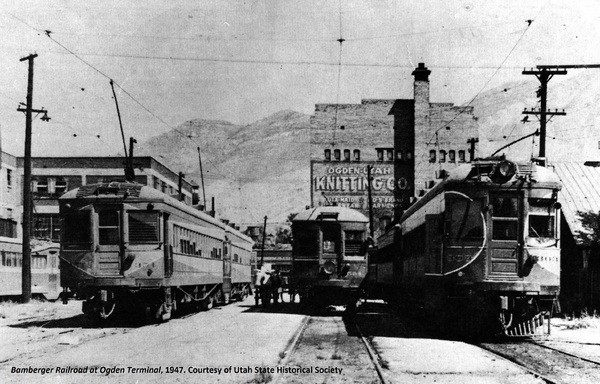Dublin Core
Title
Description
Utah’s interurban railroads were the predecessors of light rail in Utah.
At the height of the railroad age, Utah was criss-crossed with rail lines. Many of these were established to haul freight, but most of them also provided passenger service. In the more densely populated areas from Provo to Logan, electric interurban rail lines carried students to school, workers to their jobs, and shoppers to areas of commerce.
Simon Bamberger was one of the best known railroad owners in Utah. He started his Great Salt Lake and Hot Springs Railway, popularly known as the Bamberger Line, in 1890, and then continued to build northward. At Farmington, he drained a swamp and developed the Lagoon Amusement Park to compete with the Rio Grande Railroad’s Lake Park on the shores of the Great Salt Lake. With the economic boost that Lagoon gave to Bamberger’s railroad, the company built rails to Ogden by 1908 and ran five trains a day in each direction. The Bamberger Line provided the only rail access to Hill Air Force Base during the 1940s.
The A.J. Orem Company built a rail line in 1913 that served commuters between Provo and Salt Lake City. Other small railroads provided freight and passenger service to communities all over the state, including American Fork, Tooele, Tintic, Cedar City, and more. The San Pete Valley Railway was established to serve coal mines and rural areas. During the 1880s, when polygamists were being chased by federal authorities, the San Pete train signaled townspeople with coded whistle blasts to alert them that marshals were on board the train. This gave polygamists time to disappear into their hiding places, and few arrests were made. The train earned the nickname, the Polygamist Central.
So, what happened to Utah’s interurban lines? With more Utahns buying cars, especially after World War II, and with competition from buses that had greater route flexibility, most of the passenger rail lines in Utah were out of business by the early 1950s.
Creator
Elaine Thatcher for Utah Humanities © 2014
Source
Image: The Bamberger Railroad had its beginning in January, 1891, and its first run was from Salt Lake City to Beck's Hot Springs, a distance of four miles. It did not reach Ogden until 1908. It was by then operating as the Salt Lake and Ogden Railroad. It became electrified in 1910. The Bamberger made its final run from Ogden to Salt Lake City on Saturday, Sept. 6, 1952. This photograph is of the Ogden Terminal in 1947, between Lincoln & Grant on 24th Street. Courtesy Utah State Historical Society.
______________
See Stephen L. Carr and Robert W. Edwards, Utah Ghost Rails (Salt Lake City: Western Epics, 1989); and Becky Bartholomew, “Utah’s Interurbans: Predecessors to Light Rail,” at the Utah Division of State History’s History To Go website.
Publisher
The Beehive Archive is a production of Utah Humanities. Find sources and the whole collection of past episodes at www.utahhumanities.org
Date
2014-12-26

